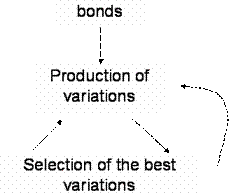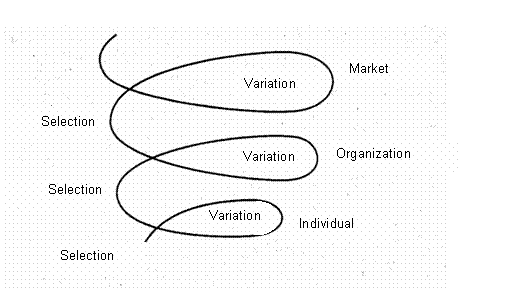Innovation is the result of a continuous process, which is the evolutive process by which organizational creativity reveals itself. And evolutive processes are essentially based on:
Let’s consider the first step, i.e. production of variations and let’s ask ourselves why innovations exist. The answer is that there is a variation of genes between a generation and the next one and it is essential to avoid the progressive reduction of learning capability.
In particular a variation is a combination of already existing elements which are fused in a different way with respect to the past. Considering this production of variations we can distinguish 3 different sources of variation:
As to the intentional combination of already existing elements we could mention several famous cases. For example Henry Ford combined the process of orders fulfilment for a postal selling enterprise and the mechanical process of car assembling, but both the processes already existed.
Ohno invented kanban technique by observing American supermarkets and analyzing the analogies between their organization and car production with a just in time approach.
A second possibility to produce variations can start from making mistakes, from something we did not want or we did not desire. For example a product which is positioned in the market differently from what has been planned might offer to the enterprise new market possibilities which were not foreseen nor planned.
Finally we have the natural production of variations, which means that variations are produced by chance. They are continuously generated by the enterprise and they create a great evolutive potential. Every day in every organization there is a random production of material which might be used to generate innovations. Then a very important aspect of creativity is concerned with the production of variations with respect to what already exists, in order to build innovation.
Moreover, one of the most common ideas about creativity is that it has to be free, without any kind of bonds. But it is not true. Actually we can say that creativity has to be guided; moreover we can talk about creativity just when we have some objectives and some bonds as a consequence.
There are two kinds of bonds for the creative process:
Moreover this kind of bonds too are not something rigid, but they can vary during the innovative process in case they are considered as a part of the evolutive process and not as a barrier.
Bonds intervene during different moments of the evolutive process and then we can distinguish among three different kinds of creativity:
a) New Darwinian creativity
The first one is called New Darwinian creativity (see fig. 2): in this case innovation is the result of an evolutive process characterized by the production of variations and by the application of bonds to select the most suitable variations and eliminate the other ones. Then individuals which have been produced by this process generate some other variations and the process starts once again. In this case selection is not random, but it is guided by some bonds which are settled by the environment. For example during brainstorming sessions participants are invited to produce new ideas without any limit by making free ideas associations. Then they have to select the rich material they have produced according to some criteria such as feasibility, cost, coherence.
Fig. 4.1- New Darwinian creativity

b) Lamarckian creativity
The second kind of creativity is the Lamarckian one (see fig. 3). In this case bonds don’t work during the selection phase, but during the generation of variations: the number of variations is limited by bonds deriving from the previous generation and so the production of variations is not dispersive. Then selection is arbitrary and it is concerned with a limited number of ideas. This kind of creativity is more efficient than the new Darwinian one, because the number of the allowed variations depends on the restrictions transmitted by the previous stadium. Then this kind of creativity is more suitable to organizations, while new Darwinian creativity can be applied to games and where individual creativity has a great preponderance.
Fig. 4.2 - Lamarckian creativity

c) Multistadium creativity
The last kind of creativity is the multistadium one (see fig. 4). Some bonds are used in the first stadium, during the production of variations, while some other bonds are used during the selection phase. According to this approach the results of creativity depend on an initial idea which has been generated considering some limits. Then this idea is improved thanks to a revisional process guided by new restrictions. A typical example comes from the research of innovation opportunities in a market which is analyzed considering some bonds, such as kind of product, customers… Once it has been individuated a new opportunity of innovation, new bonds can be introduced, such as necessary investment, or compatibility with existing lines of products and the idea is modified considering these new bonds. At this point some new restrictions could introduced, such as effects on the image of the enterprise, and the project is modified once again. The process continues till to the launch of the product in the market
Fig. 4.3 - Multistadium creativity

Now let’s analyze more deeply the selection phase. Every enterprise continuously produces new ideas about strategies, products, procedures etc. These ideas are analyzed according to a selection code which is specific for each enterprise and which constitutes the mechanism of selection. The selection code is made up of all the bonds the enterprise puts at the very basis of the innovative process. It is different from enterprise to enterprise as it is the result of the particular history of each organization. It presents some internal and external elements of evaluation and in the table below we have some examples such as mission and vision, culture, competences etc. on the internal side; and image, positioning,competitors policy etc. on the external side.
Tab 4.1 - Elements of evaluation
|
Internal elements |
External elements |
| Mission & vision | Image |
| Organizational culture | Positioning |
| Competences | Customers’ needs |
| Strategy | Competitors’ trategies |
| Existing products | Existing laws |
| Productive structure | Social and cultural values |
| Financial parameters of profitability | Competitive structure |
Then creativity is not just producing something new, but it is also the result of the mechanism which selects or refuses variations which have been produced. But there are several levels of selection. The first one is the individual level which aims to select ideas produced by individuals. The second one deals with a selection of ideas in a collective and organizational context. The last one is the level of the market where organization is inserted. Moreover the result of the selection at a certain level is considered as a variation by the superior level (see fig. 5)
Fig. 4.4 - Levels of selection

The last interesting aspect dealing with creativity as an evolutive process is concerned with acceptance and withholding of innovation. In other words the problem is how to insert innovation in the existing structures. In fact each innovation has two opposite sides at the same time: one is concerned with destruction and the other one with construction. Schumpeter, the great Austrian economist of the ’30s – ’40s synthesized this concept by saying that “Novelty destroys and builds contemporarily”.
But first of all there is a destruction of what already exists, i.e. market, product, needs, processes, structures etc. This is a necessary phase in order to make possible the next steps, that is construction, but it is never limited, nor restricted. For example a product innovation has not effects only on the market or on the environment, but it always involve the organization of the enterprise too. In the same way a structure innovation does not regard only internal structures, but it has effects on the market and on the environment too. Construction is the next step and it means using material coming from destruction. Then enterprises approach very carefully the theme of innovation because they know that it always leads to a destruction which cannot be restricted.
The problem of inserting innovation inside existing structures can be analyzed under two fundamental aspects: acceptance and withholding of innovation. The first one is connected with the destroying capabilities of innovations. Before accepting an innovation the enterprise usually evaluates its destroying capability on pre-existing structures by asking itself how deep the changing is, which structures will be modified, etc.
Once an innovation has been accepted, organizations have to withhold it. This means using it in order to solve a recurring problem, but it also means modifying organizational structures to include the innovation that works into the enterprise’s relationships. Finally innovations are more easily accepted by complex systems because they are various and articulated and then a perturbation does not destroy the whole structure, but only a part of the organization. If an organization is made up of different parts a perturbation will have different effects on them and the greater is the number and the variety of the parts, the less will be the effect on the system as a whole.
| <--PREVIOUS | BACK TO TOP | INDEX | NEXT--> |